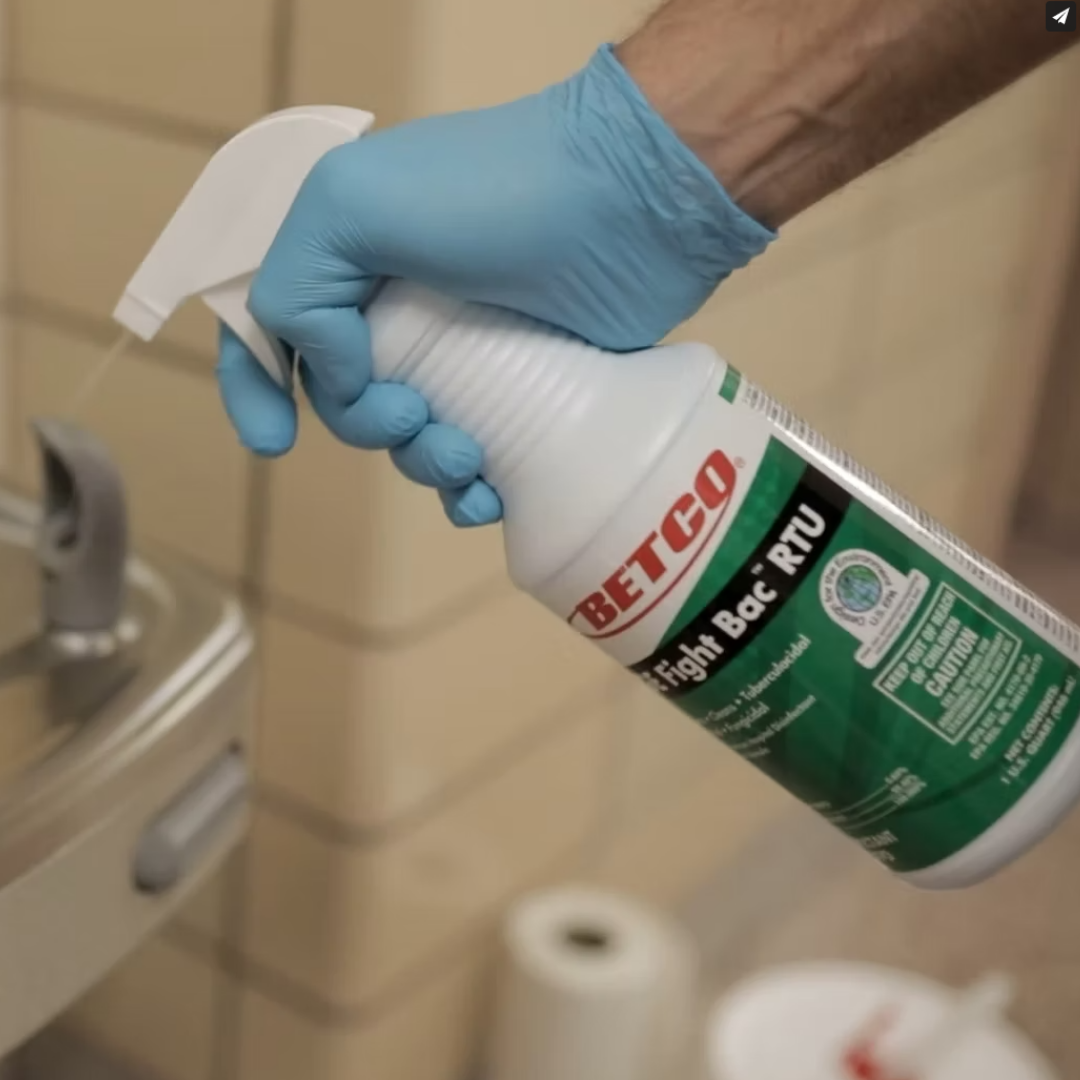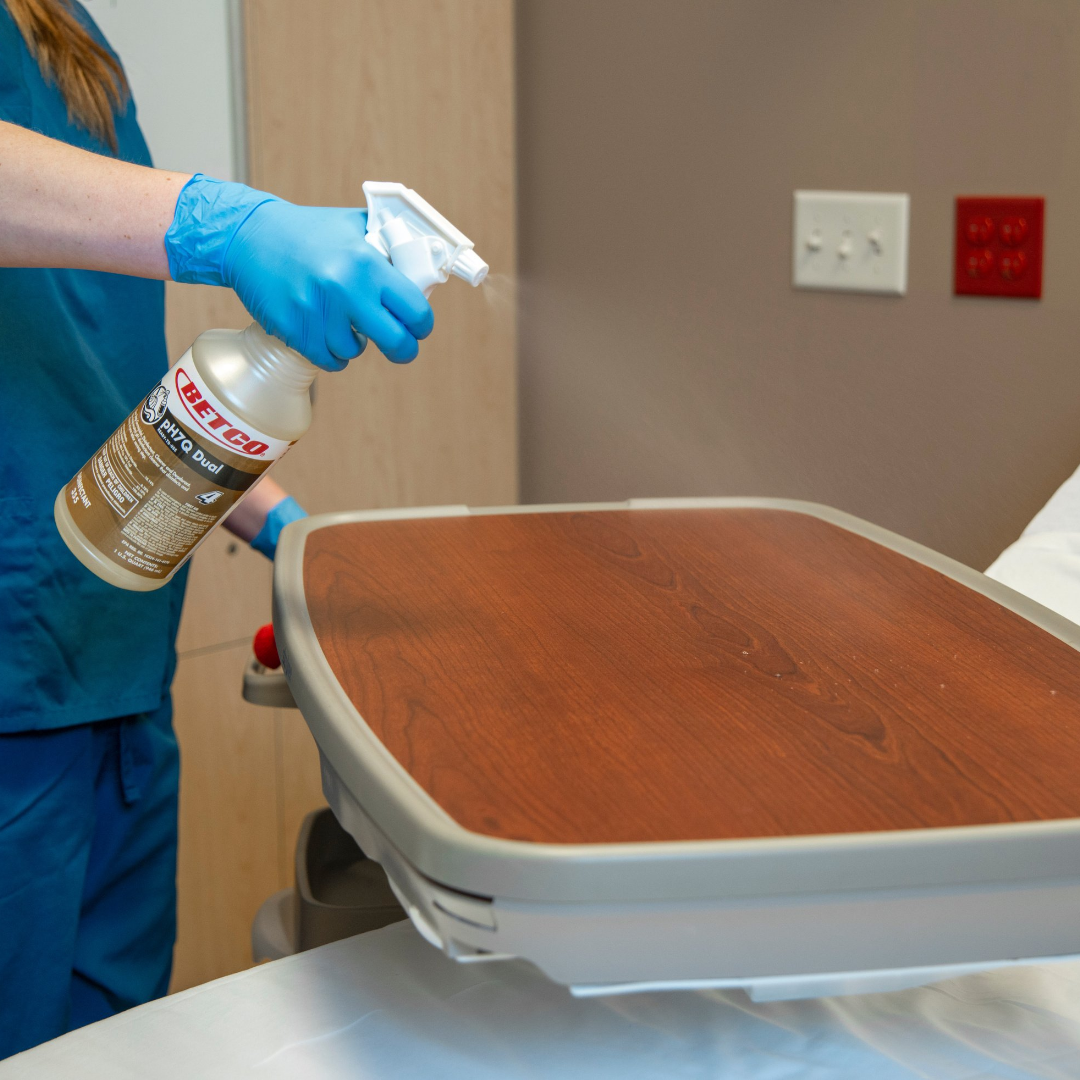The coronavirus (COVID-19) pandemic has increased the use of chemical disinfectants to prevent the spread of germs. The Centers for Disease Control and Prevention (CDC) recommends consistently disinfecting high touch point surfaces as one strategy to
combat the spread of COVID-19. With no end in sight of the pandemic, a greater use of disinfectant products is the new normal for facilities and custodian crews to keep building occupants safe and healthy.
Determining the best disinfectant for application can be challenging, especially with many different claims and benefits circulating from product to product. It is important to be knowledgeable about specific disinfectant claims and application methods.
Residual efficacy is a specific claim that grabs attention of customers because it allows the user less applications with the same efficacy of a traditional disinfectant. Continue reading to learn more and what to look out for.

What is Residual Efficacy?
According to the EPA, residual efficacy means a product provides an ongoing antimicrobial effect beyond the initial time of application, ranging from days to weeks to months. Traditional disinfectants, like List N disinfectants, will treat the
surface at the time of application but not continuously disinfect over a period of time. Residual efficacy claims market a disinfectant as long-lasting, yet there are no EPA-registered List N disinfectants with residual efficacy against SARS-CoV-2,
the cause of COVID-19.
What are the Different Residual Efficacy Claims?
The EPA has 3 types of residual efficacy claims that could be listed on a product label:
- Residual self-sanitization – liquid antimicrobials
- Products with this claim have “residual sanitization” or “residual sanitizer” on the label. It kills 99.9% of bacteria on surfaces for up to 24 hours after application and must be able to demonstrate a residual
kill within a 10-minute contact time.
- Residual self-disinfection – liquid antimicrobials
- Products with this claim have “residual disinfection” or “continuous disinfection” on the label. It kills 99.999% of bacteria and 99.9% of viruses on surfaces for up to 24 hours after application. It also must be
able to demonstrate a residual kill within a 10-minunte contact time.
- Supplemental residual antimicrobial – Antimicrobial surface coatings, films, fixed/solid, and paint products
- Products with this claim have “kills 99.9% of Staphylococcus aureus within 2 hours of exposure when used as part of a comprehensive infection control program/protocol” on the label. They are eligible to be used a supplement
to routine application for an EPA-registered disinfectant. The products kill 99.9% of bacteria or viruses for up to weeks or months and must demonstrate residual kill within 2-hours after application
Residual disinfectants must also pass abrasion testing and supplemental residual antimicrobial products must pass both chemical and abrasion testing. This testing is required to mimic real world situation where repeated cleaning will not affect the
efficacy of these products. Visit the EPA Pesticide Product and Label System to learn which products have which claims.
Can Surfaces Become COVID-19 Resistant from List N Disinfectants?
EPA-approved disinfectants on List N have been proven to kill SARS-CoV-2, kill a harder-to-kill virus, or kill a similar virus. However, no EPA-approved List N disinfectants are able to keep surfaces resistant to COVID-19 for long periods of time.
The disinfectants on List N kill the virus at the time the disinfection occurs on the surface but will not prevent new germs and viruses from contaminating it. As soon as new viral particles come in contact with the clean surface through hands,
clothes, objects, etc., the previously applied disinfectant will not be useful against the new substances.
What are Supplemental Residual Antimicrobial Products for COVID-19 on List N Appendix?
According to the EPA, traditional disinfectants kill viruses at the time they are used, while supplemental residual disinfectant products kill pathogens on previously treated surfaces for a certain amount of time. Because these products are labeled
as supplemental, they should not replace routine cleaning and disinfection products. Supplemental residual disinfectant products are not considered to be true disinfectants because they do not meet a higher standard of efficacy. There are currently
2 products on List N listed as a supplemental residual antimicrobial product type.
- Copper Armor, a supplemental residual antimicrobial – anti-viral and anti-bacterial interior paint
- Antimicrobial Copper Alloys – Group 1, supplemental residual antimicrobial – solid surface
Although they are EPA-registered and can remain effective for a long period of time, they are not considered disinfectants.
How do Disinfectants Receive a Residual SARS-CoV-2 Claim?
The EPA has a protocol in place for disinfectants to apply for a residual efficacy claim. Residual efficacy claims can only be made for products that will be used as a stand-alone disinfectant. Products must meet all standard disinfection claims and
requirements and undergo testing to support the claims. The product must also already be on List N or qualify to be on List N.
Second, products must utilize the EPA’s Residual Self-Sanitization Protocol with specific modifications for viricidal claims. As of January 13, 2022, the EPA has not approved any List N disinfectants for a residual SARS-CoV-2 claim.
What Happens to Companies That Make Unsubstantial Residual Claims?
If a company includes a residual efficacy claim not approved by the EPA on a product, it can be pulled from the market and the company can face substantial violations from the EPA, including expensive fines. Companies will also face reparations for
marketing, selling, or distributing the product.

How Do I Prevent COVID-19 with a Disinfectant?
When selecting a disinfectant, be sure to read the label for details and application directions. The label will feature all approved claims.
The CDC recommends frequently cleaning contaminated surfaces with a liquid, List N disinfectant product to prevent the spread of COVID-19 and other viruses. Betco® has multiple products on List N to help combat COVID-19. Refer to our
comprehensive
COVID-19 product guide for more information. Refer to our Disinfectant Selector Guide for assistance with selecting the right general disinfectant for your facility.
Our Enhanced Facility Disinfection (EFD) Program is another resource to ensure your facility
is abides by COVID-19 guidelines and disinfection strategies. A COVID-19 game plan, supported by evidence-based infection control strategies supported by agencies that include CDC, EPA, FDA, GBAC®, will help put the minds of facility
leadership and occupants at ease.
For more information about List N, Betco disinfectants, and EFD, or to speak with a Betco representative, please visit this link.